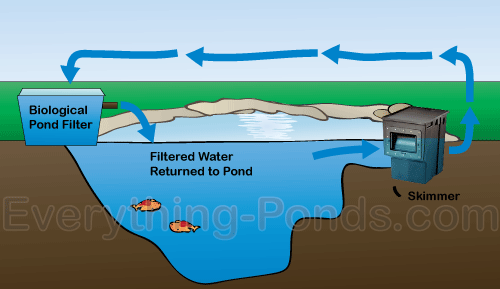What is Biological Filtration?
<< prev: 2.2.1 What is a Pond Skimmer? next: 2.2.3 What is a UV Clarifier? >>
A biological filter is one of the key pieces of equipment in an ecosystem pond. Biological filtration is a general term referring to the process of using beneficial bacteria to clean the water on a molecular level. In a natural stream or river, bacteria colonize on the stones and pebbles at the bottom of the stream, which naturally breaks down toxins as the water flows around. It is this natural process that manufactured biological filters attempt to emulate. However, in addition to cultivating bacteria at the bottom of the pond like in nature, we will also need to colonize bacteria in a biological filter to give the pond some extra help. The pond water is forced to flow through the filter via the pumping system, and as it does so, the beneficial bacteria can work to break down toxins in the water.

Why You Need Biological Filtration
One of the main uses for biological filtration is to convert harmful ammonia, which is toxic to fish and bad for a pond ecosystem, into nitrates. Ammonia is naturally produced from fish waste and other decaying matter in a pond. This is why a pond skimmer is so important—a skimmer will trap floating debris before it has a chance to sink to the bottom and decay. After ammonia is converted into nitrates, we have a much more manageable situation on our hands. Nitrates are harmless to fish in reasonable quantities and are actually a plant nutrient, acting as a source of food for plants in the pond.
However, any time you introduce plant nutrients into a pond, it’s important to keep in mind that certain types of pesky algae like blanketweed can also benefit. Therefore, it's a good idea to try to manage the levels of nitrates in your pond. There are a couple ways of doing this. The easiest way is simply to plant aquatic plants in and around your pond that will naturally feed on the nitrates, leaving less nutrients to support algae growth. Another way is through scheduled partial water changes, which replace a portion of the pond water with new nitrate- free water. Since we’re building an self-contained ecosystem pond, we’ll focus more on using plants to eat up excess nitrates than on relying on partial water changes, as might be necessary in a dedicated koi pond.
Choosing a Biological Filter
For our ecosystem pond, to keep things simple we’re going to stick with one of two types of filters:
1) Waterfall Filter
Most ecosystem ponds will include a waterfall or water feature of some kind. (See more in 1.6 - Waterfall Design.) In our opinion, the best way to incorporate biological filtration into a pond with a waterfall is to use a biological waterfall filter. Not only do waterfall filters provide the biological filtration we need, but they also act as an excellent base for building a great looking waterfall with less effort. The filter acts as both a water collection pool at the top of the waterfall and a waterfall spillway to provide an even cascade of water. It’s important to note that a waterfall filter requires a bit of care to properly conceal into the landscape. There are a few tips you’ll want to follow when choosing and installing the rocks to properly conceal the filter. We’ll cover the specifics of this in the building section later.

A biological waterfall filter before being disguised with rocks
2) External Pressurized Biological Filter
Sizing a Filter
Need help choosing pond equipment?


